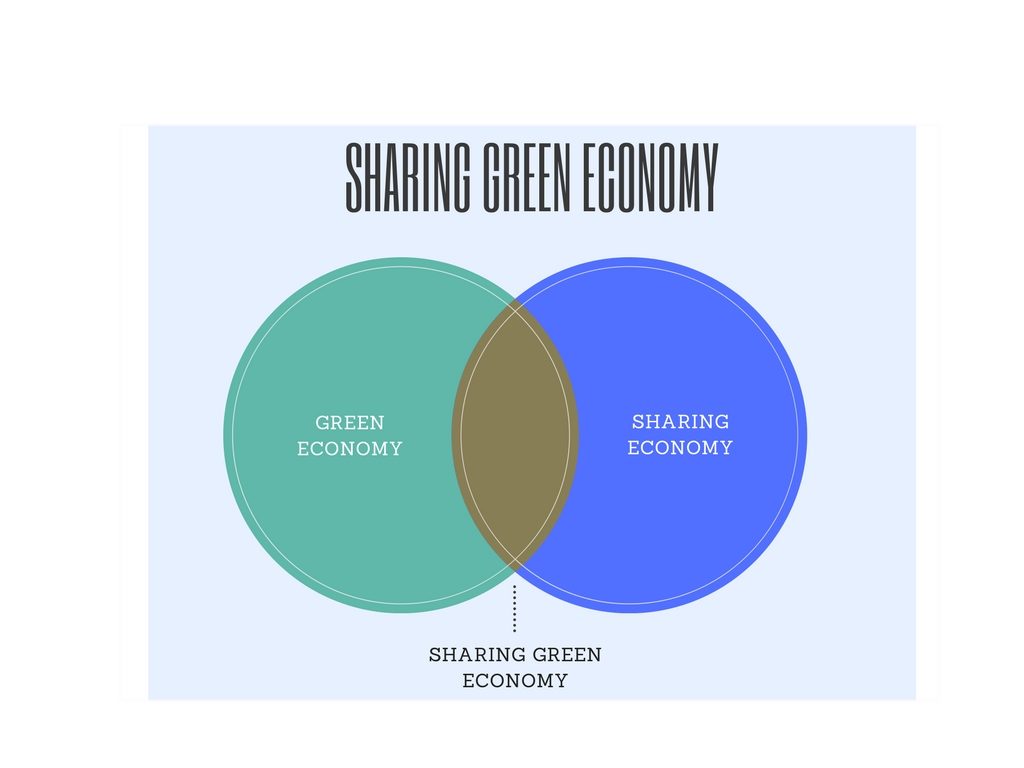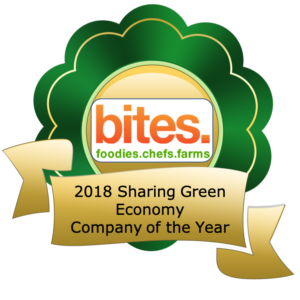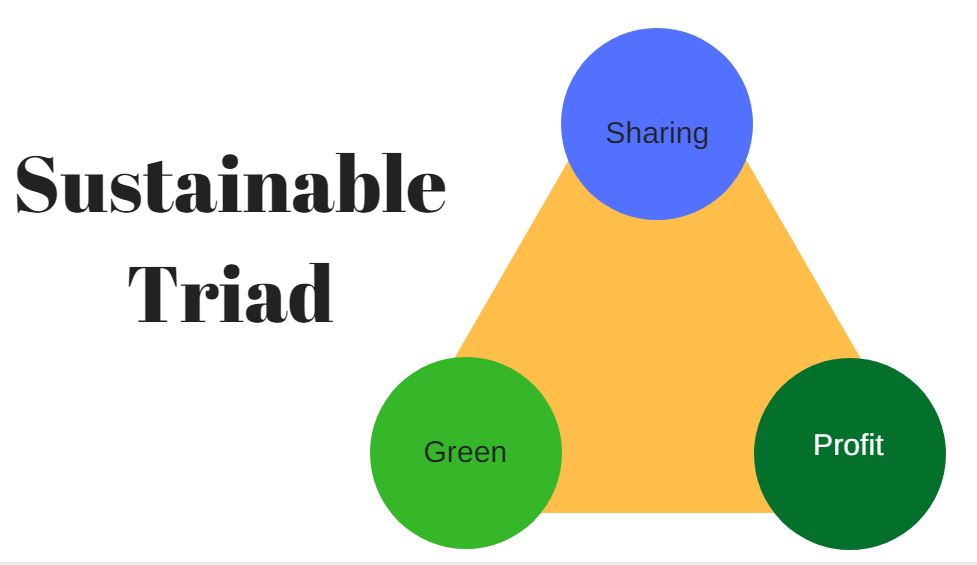
The rumblings of a movement are around us. It is the confluence of two well established initiatives: the sharing economy and the green economy. Startups that combine these two economies reap the advantages of market efficiency, environmental sustainability, low barriers to entry, agile development schemes, and social attractiveness. Sharing Green businesses bring together environmental responsibility, social connectivity, and high profit potential.
The Green Economy grew out of the ‘60s and ‘70s from authors and activists such as John McConnell, US Senator Gaylord Nelson, Dennis Hayes, Lester Brown, and Paul Hawken. It is the connection between business and protection of the environment. Businesses that embrace the green economy are said to be, “doing well by doing good,” a saying often attributed to Benjamin Franklin. It’s not a new idea, but it is an increasingly important one for the future of human existence on this planet. Initially, companies that embarked on green strategies did so at their own expense. They reduced energy usage by installing and paying for conservation measures such as energy efficient lighting, insulating buildings from exterior weather conditions. They recycled packing materials and office paper rather than sending them to the landfills. They encouraged employees to use public transportation or bicycles to commute to work. But rather than being an expense, these actions lead to an improved bottom line for many companies by improving their constituents’ attitudes toward them, by reducing costs, and by improving the health, welfare and retention of their employees. Amory Lovins coined the term ‘negawatts’ in his presentation to energy utility companies that they could make more money by selling less energy and incentivizing their customers to conserve peak energy by insulating their homes, using solar energy and buying energy efficient appliances. Today, programs such as LEED certification offer incentives for companies to conserve energy. Truly green companies weigh every aspect of activity and throughput against environmental impact always striving for a positive impact.
The Sharing Economy also has a long history, but has only recently been identified as such. Agricultural industry co-ops are a longstanding and worldwide practice. Farmers pool resources to optimize mutual benefit. They share machinery, bulk purchase inputs such as seed, fertilizer and livestock, and establish credit unions to finance their operations. Whereas conventional business models strive to maximize profit, cooperatives strive to optimize participant benefits. Agricultural coops are just one example. Sharing initiatives have exploded with the dawn of the Internet.
The driving force of the sharing economy is peer-to-peer communication and activity without, or with very minimal filtering through, intermediaries. Craigslist is a prime example of a sharing business model that has revolutionized peer-to-peer sales and communications that had been the realm of classified advertising, a key profit center for local newspapers. Craigslist allows sellers to post ads and buyers to search for things they want to buy. The service is free to most sellers and all buyers and is financed by charging for employment ads in some metropolitan areas. Craigslist was started as an electronic bulletin board in 1995 by founder Craig Newmark. It was started as a list sent out to some of his friends in the San Francisco Bay Area. It has since morphed into the the leading classified ad resource with more than 20 billion page views per month. Peer-to-peer sharing enabled by the Internet has forced the redefinition of almost every industry. The music and entertainment industry initially only fought peer-to-peer sharing such as LimeWire and Napster, but has now added its own instant sharing mechanisms to retake some of the profits lost through illegal sharing. Craigslist has crushed newspaper classified advertising.
Other key aspects of the sharing economy are collaborative consumerism, the concentration of diffuse markets, immediate reporting of negative and positive performance, rapid expansion of business models to new markets, and crowdsourcing.
The Sharing-Green Economy is the combination of environmental protection and peer-to-peer collaboration in businesses that create value for their owners. When we deliberately impart the green and sharing premises on the strategy of a business startup we get an environmentally sustainable company that is enabled by peer-to-peer transactions by engaging the efficiency of social media. These companies are a win-win for society, but they do have the potential to be disruptive to incumbents.
Ride sharing companies such as Uber and Lyft could be considered sharing-green companies. Uber and Lyft match partner-drivers with riders. Partner-drivers using their own late-model vehicles are hailed via a smartphone app. One of the hailed partner-drivers accepts the hail and the rider is notified. The match is made. Uber riders remark that Uber wait times are often only one tenth of that for traditional cabs. The standard rates are less, and the cars are newer, cleaner, and smell better. A few environmentally sustainable aspects to Uber is that Uber cars are required to be relatively new, and that translates to better emissions and fuel consumption. While cab companies lease their vehicles to their drivers on a daily basis, they have no great incentive to provide newer vehicles. The cabbies pay for the fuel they use. Traditional cabs and Uber are single-rider rides that require not only the point-to-point automobile miles but also the miles to the rider pickup point and home port for the cab or Uber driver at the end of the shift. These extra miles add to the carbon footprint of each ride and therefore have a negative impact on the environment relative to the rider instead driving his or her own car. UberPool, a newly implemented program, in some large metro areas matches riders by pick up locations and destinations so that they can share a ride and decrease their individual costs, decreasing traffic, and decreasing environmental impact.
Sharing-Green companies reduce environmental impact, optimize social involvement and create a vein of profit for the business owners. A few examples of green-sharing companies are NearBuyer.com and CloserOffice.com. These companies were deliberately cast in the mold of green sharing. Their ultimate goal is to help individuals reduce driving miles and commuting time by helping them work closer to where they live. NearBuyer matches home-owners who currently work far from where they live, requiring long commute times, with homeowners going in the opposite direction. In most large metropolitan areas, residential areas and commercial areas are interspersed, but many people don’t work near where they live. They commute across town to their jobs. NearBuyer matches homeowners who could trade homes to be closer their respective jobs. Home owner A lives across town from his office at Business A, and homeowner B lives across town from his office at Business B, but Homeowner A lives close to Business B, and Homeowner B lives next to Business A. If Homeowner A and Homeowner B traded homes, they could both walk to work. The probability of this situation is relatively small, but that is where the marketing potential of the Internet shines its brightest: the concentration of diffuse markets, bringing together participants who would not otherwise be able to find each other. Using big data tools like Zillow.com and the matching of peer provided criteria, these low probability situations can be a very valuable win-win for the participants, and it doesn’t only work for two-party matches, it could also for 3 or 4 party matches as well. Once the match is made, the homeowners decide whether or not to ‘trade’ homes. These transactions still required title companies and real estate professionals to complete the transactions, and it’s these stakeholders who are expected to fund the operations of NearBuyer.
CloserOffice is a similar concept that matches surplus office space with workers who are looking for a temporary place to hang their hats and get to work. Due to greater efficiencies or other downsizing efforts many companies are left with empty offices. Individuals who need a temporary office or are self-employed and don’t want to work from home need office space and resources like conference rooms, copiers, even receptionist services. Again, the key is matching diffuse resources with those who could best use them. Say, for instance, that a local newspaper company that expanded operations just before the Internet boom has since laid off half of its staff. It has dozens of empty offices that it could lease out to individuals or even to nearby companies.
This also has potential for lean agile scrum teams that need to separate from their parent companies so that they may remain independent of traditional institutional resistance.
CloserOffice and NearBuyer have the potential to decrease traffic, save time and energy, and provide income to their implementation teams. They are driven by community involvement and protect the environment by decreasing the carbon footprint of commuters.
Today’s chaotic political climate with its attack on environmental regulation, the efficiency of social media, and crowdsourcing make this a time rife with opportunities to expand on these doing-good ideas, drive profits locally, and protect our ecosystem without relying on the government to do so. Sharing Green companies don’t need government direction or energy utility incentives to be successful. These lean organizations focused diligently on doing good can be successful and profitable and inspire others to do likewise.
Contact: mikeduwe@gmail.com



